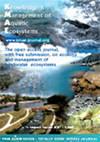美国鳗鱼对通过水力涡轮机的模拟流体剪切的弹性
IF 1.7
3区 环境科学与生态学
Q3 FISHERIES
引用次数: 3
摘要
由于商业捕鱼、栖息地改变和水坝等因素,美洲鳗(Anguilla rostrata)的数量在北美东海岸的原生范围内有所下降。美洲鳗是一种地生鱼类,在淡水生命阶段的成年鳗鱼通过水力涡轮机下游时,观察到其高死亡率(约40%)。在涡轮机下游已经观察到鱼的撕裂和切片,这些损伤通常与涡轮机转轮直接接触有关,无论是通过叶片撞击还是挤压和研磨。暴露于流体剪切也可能是损伤的来源,然而,对美洲鳗对这种物理压力源的敏感性知之甚少。与其他鱼类相比,鳗鱼相当灵活,而且缺乏其他形态特征,这些特征会使它们容易受到流体剪切的影响,比如突出的眼睛、大鳞和大肠盖。欧洲鳗鱼,以前已经测试过对流体剪切的敏感性,被发现是有弹性的。为了确定美洲鳗是否对流体剪切也有弹性,将40条美洲鳗暴露在水射流中,模拟鱼类在通过涡轮机下游时可能经历的严重流体剪切(应变速率bbb800 s−1)。暴露于严重流体剪切后,未观察到立即或延迟(48小时)损伤迹象。根据这项研究,以及之前对美洲鳗对气压创伤的敏感性进行的研究,美洲鳗在通过涡轮机时受伤和死亡的原因可能归因于叶片撞击或挤压和研磨。本文章由计算机程序翻译,如有差异,请以英文原文为准。
American eel resilience to simulated fluid shear associated with passage through hydroelectric turbines
American eel (Anguilla rostrata) populations have declined within their native range along the eastern coast of North America due to factors such as commercial fishing, habitat alteration, and dams. American eel are catadromous fish species, and high mortality rates (>40%) have been observed for freshwater life-stage adult eel passing downstream through hydropower turbines. Lacerations and sectioning of fish have been observed downstream of turbines and these injuries are commonly associated with direct contact with the turbine runner, whether through blade strike or pinching and grinding. Exposure to fluid shear may also be a source of injury, however, little is known about American eel susceptibility to this physical stressor. Eels are considerably flexible when compared to other fish species and lack other morphological characteristics that would make them susceptible to fluid shear, such as protruding eyes, large scales, and large operculum. European eel, which have previously been tested for susceptibility to fluid shear, were found to be resilient. To determine if American eel are also resilient to fluid shear, forty American eel were exposed to a water jet, simulating severe fluid shear (strain rate > 800 s−1) that fish may experience when passing downstream through turbines. No immediate or delayed (48 h) signs of injury were observed after exposure to severe fluid shear. Based on this study, and a previous study conducted on American eel susceptibility to barotrauma, the source of injury and mortality of American eel passing through turbines is likely attributed to blade strike or pinching and grinding.
求助全文
通过发布文献求助,成功后即可免费获取论文全文。
去求助
来源期刊

Knowledge and Management of Aquatic Ecosystems
环境科学-海洋与淡水生物学
CiteScore
3.70
自引率
5.60%
发文量
22
审稿时长
>12 weeks
期刊介绍:
Knowledge and Management of Aquatic Ecosystems (KMAE-Bulletin Français de la Pêche et de la Pisciculture since 1928) serves as a foundation for scientific advice across the broad spectrum of management and conservation issues related to freshwater ecosystems.
The journal publishes articles, short communications, reviews, comments and replies that contribute to a scientific understanding of freshwater ecosystems and the impact of human activities upon these systems. Its scope includes economic, social, and public administration studies, in so far as they are directly concerned with the management of freshwater ecosystems (e.g. European Water Framework Directive, USA Clean Water Act, Canadian Water Quality Guidelines, …) and prove of general interest to freshwater specialists. Papers on insular freshwater ecosystems and on transitional waters are welcome. KMAE is not a preferred journal for taxonomical, physiological, biological, toxicological studies, unless a clear link to ecological aspects can be established. Articles with a very descriptive content can be accepted if they are part of a broader ecological context.
 求助内容:
求助内容: 应助结果提醒方式:
应助结果提醒方式:


